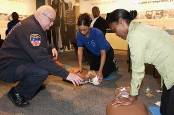
Cardiac Surgeon Sheds Light on CPR/AED Misperceptions
Dr. Glenn W. Laub, a practicing cardiac surgeon and Defibtech CEO, said the roles of cardiopulmonary resuscitation (CPR) and automated external defibrillators (AEDs) are commonly misperceived by the media and general public. Laub's remarks came in advance of the first-ever National CPR and AED Awareness Week, which begins today and runs through June 7.
"As a cardiac surgeon and advocate of public access automated external defibrillators, I believe it's very important to create awareness not only about what CPR and AEDs can do, but to correct a few common misperceptions about CPR and AEDs," said Laub, who is chairman of cardiothoracic surgery and director of The Heart Hospital at St. Francis Medical Center in Trenton, N.J. Defibtech (www.defibtech.com) designs and manufactures AEDs.
There's a difference between a heart attack and sudden cardiac arrest.
“First, to truly understand CPR and automated external defibrillators, you must know the difference between a heart attack and sudden cardiac arrest (SCA). Quite often, in media reports of life saves involving an AED, I have seen a sudden cardiac arrest victim described as having had a heart attack," Laub said. "Describing sudden cardiac arrest and heart attack as synonymous is incorrect. Sudden cardiac arrest is an arrhythmia--a disorder of the heart's electrical activity causing an abnormal heart beat--while a heart attack is a plumbing problem; an artery leading to the heart becomes clogged, causing an insufficient blood supply to the heart. In some cases, a heart attack can contribute to SCA."
Rescue response to SCA and heart attack victims can be different.
"Second, the difference between SCA and a heart attack is important to consider in relation to CPR and AEDs because the rescue response to victims of each disorder can be very different. For example, recent news reports have suggested that CPR alone can save an SCA victim; that’s not correct--only a defibrillator can 'reboot' the heart, making it beat normally again. In SCA cases, CPR can only buy time, helping to support blood circulation until a defibrillator arrives and after the heart resumes its normal rhythm.
"When rescuers arrive on the scene, they have no way of knowing whether the victim has had SCA, a heart attack, or elements of both. In these cases, a rescuer with an AED can use it to analyze heart rhythm and determine whether or not a victim is suffering SCA. While an AED can bring an SCA victim's heart rhythm back to normal, neither an AED nor CPR can definitively treat a heart attack victim because neither of these treatments can fully restore adequate blood flow and begin to mitigate the damage being done to the heart muscle while an attack is in progress. As in all situations involving emergency rescue, calling 9-1-1 is very important because a heart attack victim must be transported to a hospital as quickly as possible for treatment to restore blood flow. This treatment commonly involves opening the blocked artery with surgery, medications, or with a percutaneous coronary intervention (balloon angioplasty and stent)."
Heart disease has reached epidemic proportions.
"Third, as communities and organizations across America consider responses to the threats posed by SCA and heart attack, they have to realize the raw numbers--proof that these disorders are reaching epidemic proportions. Most Americans, I believe, don't grasp the extent and seriousness of heart disease, as well as how it can be prevented," Laub said. "According to cardiac care experts, heart attack strikes about 1.2 million Americans each year, with the majority of those surviving to receive in-hospital care. A majority survives because many heart attacks are mild and not lethal and because many community members are trained on how to assist heart attack victims.
"SCA, on the other hand, doesn't strike as many people as heart attack but claims 90 to 95 percent of its victims--more than 325,000 a year--more fatalities than car accidents, breast and prostate cancer, handgun violence, fires and AIDS combined. In many SCA cases, an AED is not available onsite and emergency medical services arrive too late to help. However, as many as 40,000 lives could be saved annually with broad public access to on-site defibrillators, according to estimates, because studies show that if victims are defibrillated within the first three to five minutes after arrest, 50 to 70 percent survive."
Both AEDs and CPR are needed.
"Finally, to address two problems affecting more than 1.5 million Americans each year, we must remember that CPR is not a substitute for having an AED, just as having an AED is no substitute for individuals trained in CPR. We need both," Laub said, "along with carefully considered response plans involving trained AED/CPR rescuers in public buildings, workplaces, police and fire departments, schools and churches, health clubs, airports, hotels, restaurants, and wherever else large numbers of people frequently gather.
"With these actions, we can significantly increase the number of individuals surviving SCA and heart attacks. AEDs have become so easy to use that even a young child can be trained in minutes to save someone's life. Thousands across the country have received AED/CPR training, and thousands more should take advantage of this opportunity. A life saved due to these efforts could be your own or that of someone you love."